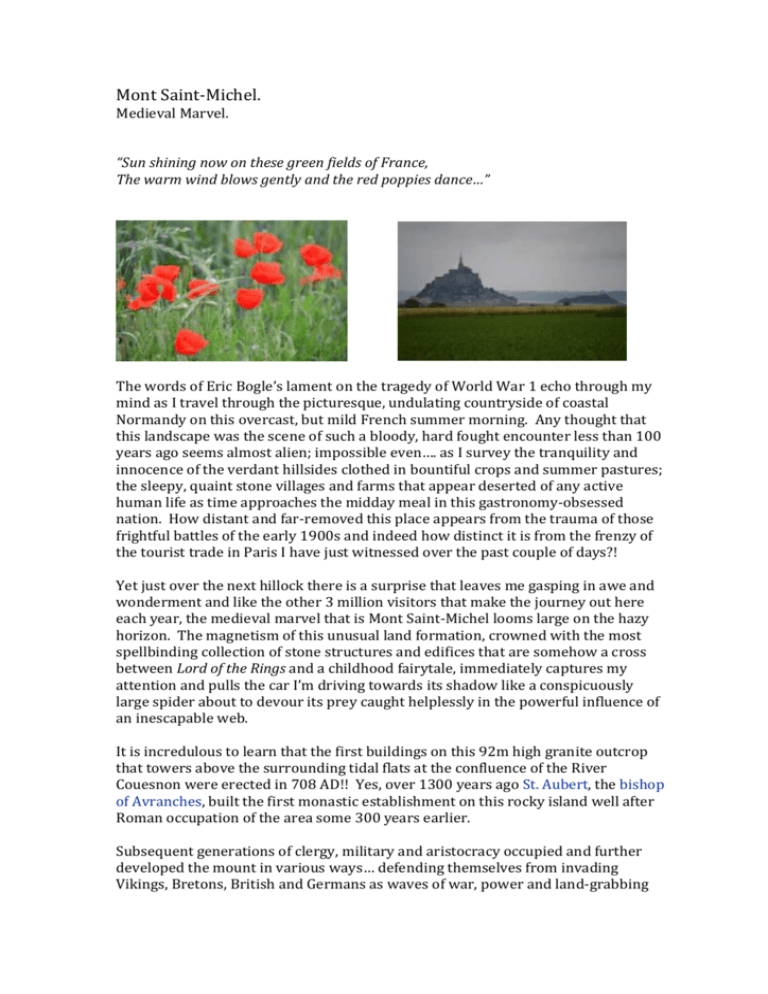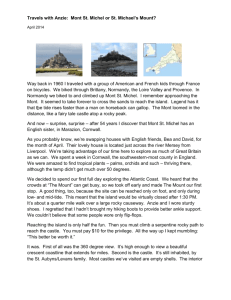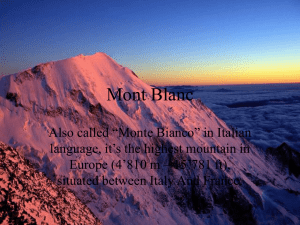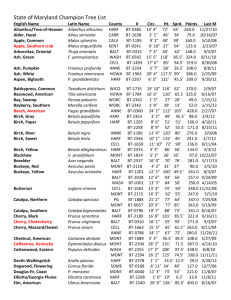File
advertisement

Mont Saint-Michel. Medieval Marvel. “Sun shining now on these green fields of France, The warm wind blows gently and the red poppies dance…” The words of Eric Bogle’s lament on the tragedy of World War 1 echo through my mind as I travel through the picturesque, undulating countryside of coastal Normandy on this overcast, but mild French summer morning. Any thought that this landscape was the scene of such a bloody, hard fought encounter less than 100 years ago seems almost alien; impossible even…. as I survey the tranquility and innocence of the verdant hillsides clothed in bountiful crops and summer pastures; the sleepy, quaint stone villages and farms that appear deserted of any active human life as time approaches the midday meal in this gastronomy-obsessed nation. How distant and far-removed this place appears from the trauma of those frightful battles of the early 1900s and indeed how distinct it is from the frenzy of the tourist trade in Paris I have just witnessed over the past couple of days?! Yet just over the next hillock there is a surprise that leaves me gasping in awe and wonderment and like the other 3 million visitors that make the journey out here each year, the medieval marvel that is Mont Saint-Michel looms large on the hazy horizon. The magnetism of this unusual land formation, crowned with the most spellbinding collection of stone structures and edifices that are somehow a cross between Lord of the Rings and a childhood fairytale, immediately captures my attention and pulls the car I’m driving towards its shadow like a conspicuously large spider about to devour its prey caught helplessly in the powerful influence of an inescapable web. It is incredulous to learn that the first buildings on this 92m high granite outcrop that towers above the surrounding tidal flats at the confluence of the River Couesnon were erected in 708 AD!! Yes, over 1300 years ago St. Aubert, the bishop of Avranches, built the first monastic establishment on this rocky island well after Roman occupation of the area some 300 years earlier. Subsequent generations of clergy, military and aristocracy occupied and further developed the mount in various ways… defending themselves from invading Vikings, Bretons, British and Germans as waves of war, power and land-grabbing followed one another throughout the amazing course of history in this part of the world. Through it all, Mont Saint-Michel has stood the test of time and turbulence, not least of which is the unbelievable tidal influences along this fascinating coastline. Considered the largest tidal variations on earth, the difference between low and high tides can be as much as 14 metres in any one event! Coupled with the nearby river’s movement, the current surges are powerful and swift and have left many Mont Saint-Michel visitors in a spot of bother as they scramble to rescue themselves and vehicles from the silty swamping of the single access to the captivating conglomeration this stimulating structure represents. Mont Saint-Michel and its bay were added to the UNESCO list of World Heritage sites in 1979 reserved for criteria such as cultural, historical and architectural significance as well as human-created and natural beauty. The French government has continued to promote the site as one the nation’s major tourist attractions and despite its heritage significance and the volume of visitors received each year, Mont Saint-Michel is a thriving commercial centre adorned with accommodation options, restaurants, cafes and souvenir shops, all sensitively installed within the historic architecture, but providing contemporary comfort and convenience to the throngs of daily tourists. All quite amazing when compared with the Australian approach to managing ‘European heritage’ sites (few of which are much over 150 years old!) and most that seem to discourage alternative commercial use options! Even the Tour de France regularly uses Mont Saint-Michel as a stage set for its annual cycling event. This year was no exception with an individual time trial finishing at the foot of this spectacular site, adding to the grandeur and ambience of the largest annual sporting event in the world! Major redevelopment work on the access to the rock is currently being undertaken with millions of euros being spent on the construction of an elevated causeway for the carriage of double-ended ‘navettes’ or shuttle-buses that ferry people between the site and a large, contemporary visitor centre that provides interpretation, information and rest rooms near the massive car-parking facilities3 kilometres from the mount itself. After alighting from the shuttle-bus and wandering through the commercial village centre at the base of the fortified rock, a series of winding stone steps takes visitors up through the gardens and residences of the site towards the dominant Romanesque Abbey perched on the crown of the mount. It is this edifice with its towering spires, vaults and arches that captures the amazement and awe of every visitor. Throngs of people seem to vanish into the crypts, chambers and recesses of this magnificent structure as the random procession of tourists meanders casually up the spiraling staircases, through the seemingly endless levels of the foundations of the abbey and eventually emerge in the cavernous upper storey that is the cathedral itself on the summit of the rock. A verdant, manicured cloister garden just outside the church is an unexpected surprise at that level but simply adds to the captivating ambience of this unique site. It is truly a remarkable experience and despite the numbers of people visiting at any one time, there still appears to be enough space and opportunity to escape from queues and crowds and to absorb the impressive views way out over the sandy tidal flats dotted with school groups and aimlessly wandering individuals seeking a different and solitary perspective of the mount at low tide. The passage of people flows in a sort of orderly fashion in a single direction through the myriad of medieval corridors and eventually returns to the starting point at the base of the monastic establishment above the village. It is difficult to actually decide to leave Mont Saint-Michel. It is so inspiring, so absorbing and so profoundly unbelievable that it feels like there is always something more to discover! I chose to take advantage of the still distant tidal waters and wandered out onto the exposed sand where the ground-level view of the whole mount appears to accentuate its grandness and emphasise the defiance of its fortress like walls and superior defence capabilities. That opportunity affords me the chance to survey the whole site in its entirety …and in relative silence. Out on the sand the hum of the tourist trade, maintenance and construction activity and daily routine in this remarkable eighth century development are dissipated in the salt air; the cries of hungry gulls and the excited chatter of French school children discovering the delights of the seashore. ….Je t’aime Mont Saint-Michel! Christopher McCormack Freerunning 0437 493 303











